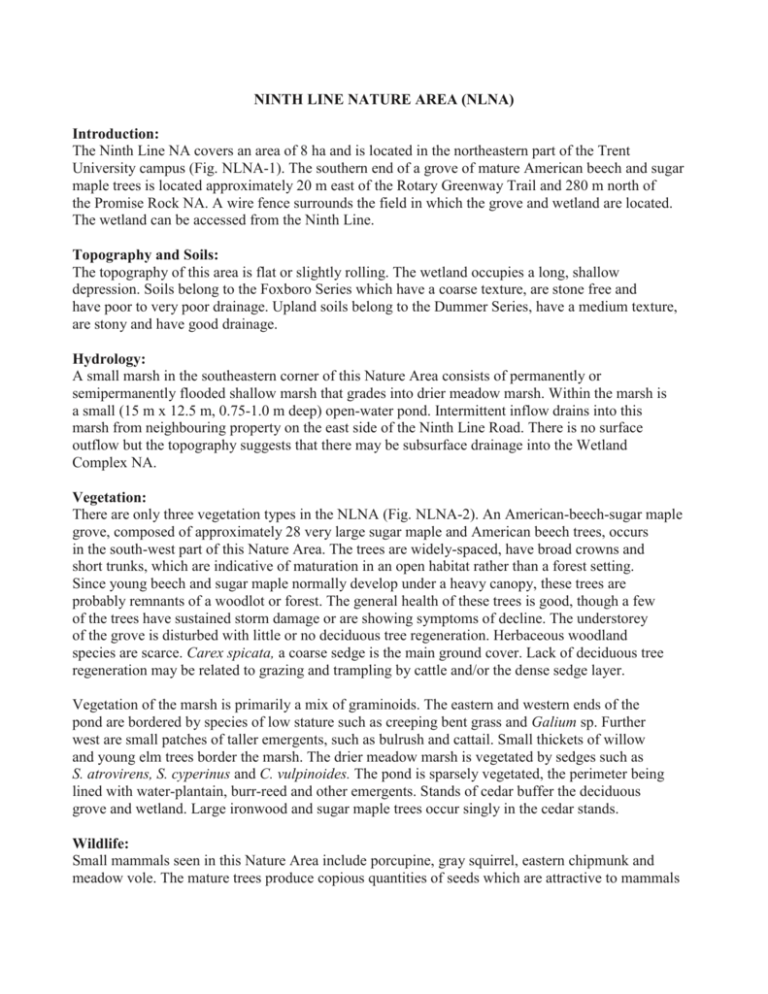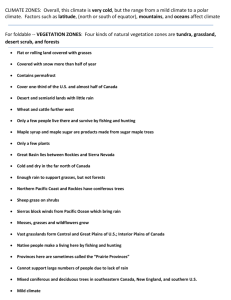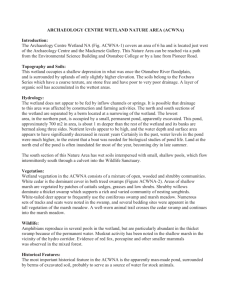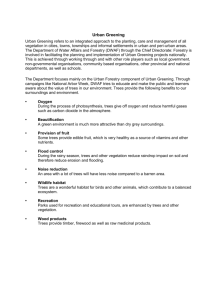NINTH LINE NATURE AREA (NLNA)
advertisement

NINTH LINE NATURE AREA (NLNA) Introduction: The Ninth Line NA covers an area of 8 ha and is located in the northeastern part of the Trent University campus (Fig. NLNA-1). The southern end of a grove of mature American beech and sugar maple trees is located approximately 20 m east of the Rotary Greenway Trail and 280 m north of the Promise Rock NA. A wire fence surrounds the field in which the grove and wetland are located. The wetland can be accessed from the Ninth Line. Topography and Soils: The topography of this area is flat or slightly rolling. The wetland occupies a long, shallow depression. Soils belong to the Foxboro Series which have a coarse texture, are stone free and have poor to very poor drainage. Upland soils belong to the Dummer Series, have a medium texture, are stony and have good drainage. Hydrology: A small marsh in the southeastern corner of this Nature Area consists of permanently or semipermanently flooded shallow marsh that grades into drier meadow marsh. Within the marsh is a small (15 m x 12.5 m, 0.75-1.0 m deep) open-water pond. Intermittent inflow drains into this marsh from neighbouring property on the east side of the Ninth Line Road. There is no surface outflow but the topography suggests that there may be subsurface drainage into the Wetland Complex NA. Vegetation: There are only three vegetation types in the NLNA (Fig. NLNA-2). An American-beech-sugar maple grove, composed of approximately 28 very large sugar maple and American beech trees, occurs in the south-west part of this Nature Area. The trees are widely-spaced, have broad crowns and short trunks, which are indicative of maturation in an open habitat rather than a forest setting. Since young beech and sugar maple normally develop under a heavy canopy, these trees are probably remnants of a woodlot or forest. The general health of these trees is good, though a few of the trees have sustained storm damage or are showing symptoms of decline. The understorey of the grove is disturbed with little or no deciduous tree regeneration. Herbaceous woodland species are scarce. Carex spicata, a coarse sedge is the main ground cover. Lack of deciduous tree regeneration may be related to grazing and trampling by cattle and/or the dense sedge layer. Vegetation of the marsh is primarily a mix of graminoids. The eastern and western ends of the pond are bordered by species of low stature such as creeping bent grass and Galium sp. Further west are small patches of taller emergents, such as bulrush and cattail. Small thickets of willow and young elm trees border the marsh. The drier meadow marsh is vegetated by sedges such as S. atrovirens, S. cyperinus and C. vulpinoides. The pond is sparsely vegetated, the perimeter being lined with water-plantain, burr-reed and other emergents. Stands of cedar buffer the deciduous grove and wetland. Large ironwood and sugar maple trees occur singly in the cedar stands. Wildlife: Small mammals seen in this Nature Area include porcupine, gray squirrel, eastern chipmunk and meadow vole. The mature trees produce copious quantities of seeds which are attractive to mammals and birds. In the past, the area comprised part of the nesting territory of a pair of greathorned owls. The marsh contains a rich assemblage of aquatic life. It provides reproductive habitat for seven species of amphibians, including one unidentified species of salamander. Many kinds of aquatic invertebrates were noted at the wetland including several types of damselflies, dragonflies and snails. Great blue herons and a variety of small songbirds such as common yellowthroat are commonly observed in this area. Historical Features: The Rail Trail runs along the western edge of the area. Significant Features: The mature American beech and sugar maple trees are of impressive size. Groves of large trees in a natural setting are uncommon in this municipality. The wetland supports a variety of wetland plants, some of which may be uncommon in Peterborough County, for example Alopecurus aequalis. Aquatic animal life in the shallow marsh appears more abundant and diverse than in other similar campus wetlands. Land Use: Farming The NLNA and fields surrounding this Nature Area are leased for farming and are used for pasturing cattle. That cattle pasturing has occurred for many years is suggested by the cropping of the lower branches of cedar trees. Cedar trees were selectively harvested from the coniferous woodland until recently. Teaching and Research Distance from the campus core is probably the reason this area is little used for teaching. The beech-maple grove is used as a field site by students in ERS for forestry management studies. The pond is used for amphibian research by Masters and Doctoral students. The woodland could be used for studies of the impact of grazing on such habitat. Recreational Use There are no trails in this area which is visited only by occasional walkers. A wire fence separates this Nature Area from the Rail Trail. Adjacent Land Use: Cultivated fields border the eastern and southern parts of this Nature Area. To the west is the Rotary Greenway Trail bounds the Promise Rock NA and the Otonabee River Ecological Integrity: There is concern that: • that trampling by cattle in and around the pond causes damage, such soil compaction and rutting, bank erosion, to vegetation by trampling and increase nutrient levels in the pond. Cattle, however, are preventing invasion of these areas by white cedars. • the large American beech and maple trees are susceptible to wind damage during storms. Figure NLNA-1: Contour Map of the Ninth Line Nature Area, Symons Campus, Trent University, Peterborough, Ontario. Figure NLNA-2: Vegetation Types in the Ninth Line Nature Area, Symons Campus, Trent University, Peterborough, Ontario. Figure NLNA-3. Vegetation Communities in the Ninth Line Nature Area, Symons Campus, Trent University, Peterborough, Ontario.








